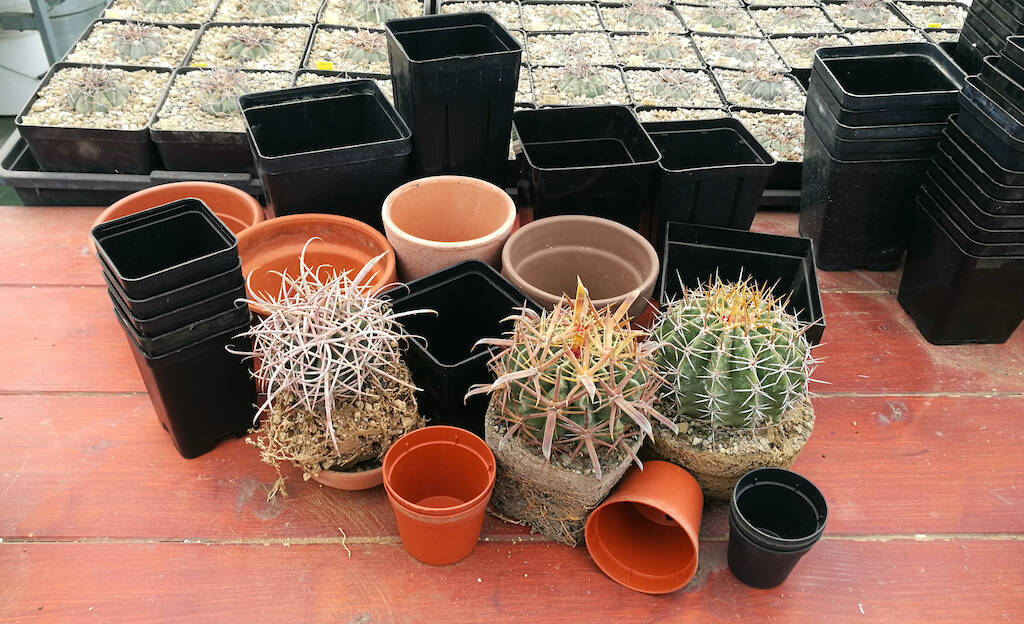Plastic or terracotta pots? Round, square, shallow or deep? And then again: is it better to have one plant per pot or several plants in one box or in a large bowl? At first glance, the subject may seem trivial, but the choice of the right vase for growing cacti and succulent plants has an undeniable impact on the consequence of the cultivation. The choice of the right pot, it can be said, is indeed closely related to the type of cultivation we adopt for our plants (indoors, on a balcony, in a greenhouse, in the open air, etc.) and to the various elements that characterize it, such as watering, type of substrate, exposure, temperature, and much more.
Net of purely aesthetic and therefore personal choices, let’s see how to choose the right containers for succulents’ cultivation, evaluating the pros and cons of the various shapes and materials with which the pots available on the market are made. (…)
Foreword
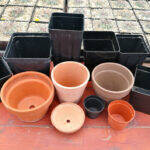
Cacti and succulents, in general, are very tolerant and adapt to various methods of cultivation. This is another reason why the choice of the pot is often dictated almost exclusively by aesthetic reasons. Over the years, I have seen cacti grown in enamelled pots, in bonsai pots, or in tin pots, if not in recycled cans, or even in elegant wooden containers. The aesthetic aspect is not up for discussion: it is personal and gives little or nothing to “reason”, that is, the pros and cons of cultivation. In short, in these cases, the pot is chosen because it is liked. This is not the idea of cultivation I’ve had through the years, as those who follow this site know, based on the plant’s wellbeing and on obtaining robust specimens that look as much as possible like those plants in nature. For myself, concerning the use of pot or container, the aesthetic aspect is definitely in the background. I’m not saying that I don’t appreciate a beautiful setting in an aesthetically pleasing vessel (I’ve made more than one myself over the years): I’m just saying that for the vast majority of my plants, the choice of the pot is dictated first and foremost by “functional” reasons and in this area, as we will see later, countless considerations have to be made, pros and cons to be weighed case by case.
Vases, bowls, cassettes: the types
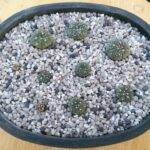
Beyond the compositions, which bring together several plants in a single container – often neglecting that plants have very different cultivation needs – succulent and cacti can be grown in single pots or in large containers, such as bowls or crates, capable of accommodating a variable number of specimens. The pros of the choice of the single vessel are obviously the saving of space, the simplification obtained in the management of a single container (even if heavy) compared to the moving of many little pots and in fact that in single pots, the plants have more space to expand their roots and, consequently, more soil. The cons of this choice, however, are significant. Firstly, some plants will colonize the space faster, spreading their roots at the expense of others, with the result that the latter will grow more slowly and remain smaller. Secondly – and in my opinion, this is the most important consideration – in case of disease, we risk losing all the specimens and not only the one initially affected. Let’s think of a cochineal attack, for example: in plants in close contact, the parasite will soon pass from one specimen to another. Worse still in case of root parasites or fungal diseases, in particular, those originating from bacteria present in the soil: in these cases, the affected plant will quickly share the problem with all the others grown in the same container, and we risk losing not one but all the plants grown together.
Another risk for that plants grown in single containers is related to watering. If we water at the wrong time or exceed it (especially if the soil is not correct), we’ll have water stagnation that will affect all. Because of this, I have been growing my plants in single pots, limiting the cultivation of multiple specimens in single boxes or bowls only to some succulents such as Lithops, Crassula, Sempervivum and Echeveria, or particularly strong cacti such as Echinopsis. I also grow my seedlings in single containers for obvious reasons: I place several seeds in the same vessel, and for one or two years after germination, the seedlings remain in that same container. When I have to replant the seedlings, I consider the size of the single specimen. I put plants of two or three centimetres in single pots, while smaller ones will share boxes, seed pots or Styrofoam containers, well-spaced between them to allow the correct root development. In some cases, it has happened to me to lose some single specimens of my sowings because of rottenness, but fortunately, I have never had collective deaths, not even in all those cases in which I have limited myself to remove the rotten specimen without removing the others grown in the same container.
Plastic, brick, aluminium: the materials
On paper, we could say that by now, we are spoilt for choice, as we can easily find pots in plastic, terracotta, aluminium, wood, stoneware, glass, glazed terracotta and other materials. If time ago terracotta was considered the best, today the possibilities are really endless, also considering… the creativity, which can lead to making vases with recycled objects, such as milk, cans, containers of various shapes and sizes…
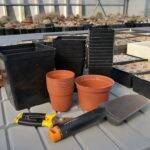
Plastic – While it is true that every material has its merits and demerits, as far as I am concerned, plastic and terracotta remain the two most viable alternatives. Having thousands of plants over the years, I have definitely switched to plastic (although from an environmental point of view, it is not the best…). The reasons that can lead to prefer plastic pots, which are easy to wash and recycle, are many: first of all, the weight, which is decidedly low compared to one of the terracotta pots. This may seem a minor consideration, but when you have many plants to move twice a year from the greenhouse to the outside (and vice versa), your back will tell you that there is no match between plastic and terracotta.
Another characteristic of plastic is that it does not allow any transpiration from the inside to the outside. In other words, the walls of plastic pots, differently from the terracotta pots, do not allow any air exchange between the substrate and the outside. This cause that water to take longer to evaporate, as it can only evaporate up to the surface. So we will have to learn to calibrate the watering according to the pot size (a 2-inch pot contains very little soil compared to a 10-inch pot, for example) and, above all, according to the substrate composition. Of course, the bulk of the work will be done by the plant itself (in addition to the drainage holes in the bottom, which are necessary for any pot), which absorbs water from the substrate, contributing significantly to the substrate drying quickly. And this brings us to the advantage of plastic over terracotta: by retaining moisture longer with plastic pots, we can water at longer intervals. When you have many plants, this is a “detail” that loses the connotation of “detail” to gain value.
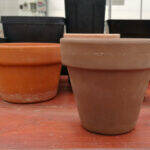
Terracotta – Terracotta pots are undoubtedly more environmentally friendly, more pleasing and natural to the eye and retain (at least in my eyes) an undeniable retro charm. It’s reasonable to opt for terracotta if you have a few plants, and you don’t need to move them several times during the year. However, you have to consider that terracotta allows transpiration from the pot’s inside to the outside, with the consequence that the soil will dry more quickly. While this at first glance may seem like an advantage, in the warmer months, the substrate if very draining, and it will dry out so fast that close watering will be necessary (in summer, even every other day). As long as you have only a few plants, this is not a problem, but when we start to get the hang of it, and the specimens exceed a hundred, watering them all every other day becomes almost another day job: try it!
The third disadvantage of using plastic is generally discovered during the first repotting, especially when you do it after some years. Thanks to the porosity of terracotta, in fact, the roots of the plants, once the colonization of the soil is over, literally cling to the inner edges, so they can take advantage of the humidity that permeates the pots themselves. Over time, the capillary roots cover the pot’s inner rim, forming a sort of “felt” that glues the plant to the vase. When repotting, nine times out of ten, after sweating (and probably swearing) for an interminable amount of time, you will find that the only way to get the plant out of the pot is to take a hammer and crumble the terracotta. At that point, you’ll have more tears to shed: some for the vase itself, which you’ll no longer be able to use, and others for the work ahead of you to break up the loaf of soil and free the felted roots, compact and tangled like the plot of a psychological thriller.
With plastic pots, to flare the plant, most of the time is sufficient to turn the pot upside down, or, in case of large or particularly thorny plants, wrap the plant with a cloth and pull it out of the pot. The only difficulty, when repotting succulents in plastic pots, I found when I let several years pass since the previous repotting: in those cases, the plant had fully colonized the soil, deforming the vase under the pressure of the roots and making it almost impossible to extract, to the point that I could only cut it with a cutter.
Terracotta pots, as plastic pots, are also easily recycled and can be washed, although it takes longer due to the material porosity.
Aluminium, glass, wood – With other non-transpiring materials, such as glass and aluminium, the same considerations listed for plastic and related to non-transpiration of soil are valid. However, we have to add the defect that characterizes terracotta, the pot’s weight (at least if we have vases with hard size). Since aluminium and glass containers are generally made for purposes other than plant cultivation, or at best are used as pot covers, it is essential to make sure that drainage holes are present at the bottom: never use pots closed at the bottom (and this applies not only to succulents but to any plant). Wooden pots and containers can be very aesthetically pleasing, but unless they are covered with a plastic sheet inside or treated with special paints, they are destined to become impregnated with water and, over time, to deteriorate and rot, especially in case of outdoor or greenhouse cultivation, with a sprinkling of water.
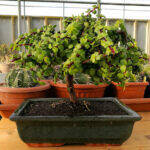
Enameled pots for bonsai – Evergreen pots for bonsai have always been very appreciated and used by cacti and succulents growers. From an aesthetic point of view, they can be real works of art, but from a functional one, suitable for growing succulents only in some cases. This is mainly due to their shape, generally box-shaped and therefore wide and low, so not very compatible with the expansion of the roots in-depth and not recommended for plants with taproots, such as Ariocarpus, Lophophora, certain Coryphantha, certain Mammillaria and many other cacti. Moreover, unless the inside is enamelled, it’s better to avoid bonsai pots in the cultivation of succulent plants: if we leave the plant for too many years in the same container, the only way to take it out will be to break the pot. A real shame, considering the aesthetic and economic value of this type of vases.
Round or square, high or low?
Regarding the shape of the pot, there is little to discuss on a functional level: here, it’s more a matter of taste because the plants adapt perfectly to any type of container, be it round or circular. Generally speaking, it can be said that shallow and wide bowls are better suited to accommodate globular or tall cacti, while traditional cone-shaped or cylindrical pots are aesthetically more suitable for columnar succulents.
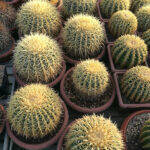
One factor that can play a significant role in the option when you have many plants is undoubtedly space-saving. In this case, the square pot is the first choice: it has been specially designed to ensure the full use of space by the plant and, with the same size as a round pot, the square pot contains more soil. And that’s not all: if placed side by side, square vases avoid considerable waste of space compared to circular vases, which, even when placed side by side, will not allow to fully exploit benches or shelves, leaving triangles of empty space between one edge and the other. If with few plants, this consideration can have a relative weight, with hundreds or thousands of specimens, the choice becomes almost compulsory, unless you have a considerable number of huge greenhouses. It is no coincidence that square pots are the ones most used by collectors and specialized nurserymen. Whether you opt for the square pot or the round one, there are two elements to consider when repotting the plant. The first one is the steam size, the second one is the size of the root system. In both cases, there must be a proportion between the plant and the container. As for the stem, the choice is simple and entrusted to aesthetic canons, keeping in mind that it is appropriate that the pot can easily contain the body of the plant and, possibly, the thorns (unless these are exceptionally long, as in the case of some Lobivia or some Ferocactus). As a general rule, it’s recommended there can be two to four or five centimetres between the stem and the pot’s edge.
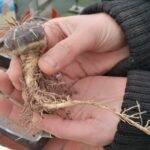
However, concerning the root system, the evaluation requires some experience and a surplus of observation when we’ll have flared the plant. First of all, if we are dealing with a cactus with a taproot (i.e. a “carrot” root, as in Ariocarpus), it’s necessary to use high pots, where the taproot can be comfortably accommodated, and the rootlets can develop in-depth rather than width. In these cases, we will avoid bowls and choose cylindrical or square pots instead (in the last years, you can find high pots for plants like Ariocarpus, Lophophora, etc.). If, on the other hand, the root system is not taprooted, we will have to evaluate based on the specimen to be repotted: if the roots are short and thick or if we see that they tend to develop horizontally (this is the case of Echinocactus and many Ferocactus, for example), we can use low and wide bowls or square pots that are not too deep (with the same length of the side, there are high square pots and low and squat square pots).
One thing, based on my experience, I can affirm: cacti and succulents, contrary to what has been believed for years (and contrary to what too many enthusiasts still believe), do not fear large spaces in which to grow. Miniature pots are an imposition and only limit the growth of the plant. On the contrary, if the soil is balanced and draining, ample and deep pots favour the correct plant’s development of the plant without exposing it to the risk of water stagnation that can trigger rottenness.
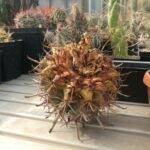
It is a different matter if the plant is suffering and the root system is compromised or absent because, in these cases, the choice will fall on low pots and bowls, which we will fill with pumice for helping the plant emit new roots. Large pots can be inadequate if the roots are missing or suffering, because they contain an excessive quantity of soil which not absorb the watering and will remain too long in a wet substrate, if not soggy. So initially, it’s better to use pots and bowls that are not bigger than the ones of the stem, postponing to a second time – at least a couple of years later when we are sure the plant will be healthy again – the repotting in a container suitable for the size of the specimen and for the new root system.
Cactus without roots: how to intervene to save the plant and make it healthy again.
Colours and particularities of pots
From a functional point of view, the importance of the pot’s colour is not so relevant. Some say that black pots can be dangerous because, by attracting and keeping more sun rays, they could favour the substrate overheat and causing the roots to suffer. Theoretically, the argument is not out of place, but for over twenty-five years, I have been using black pots (the classic square pots for growing), and I have never had problems due to overheating of the roots, even in plants that I keep outside the greenhouse, exposed to direct sunlight. In short, I have never experienced any difference from the plants I grow in terracotta-coloured plastic pots, even when, in the middle of summer and after hours of direct sun, they are hot.
I know growers who have the patience to cover the outside of their pots with white tape, just as I know a brilliant grower, David Rubbo, who has the patience to “insulate” many of his pots. He cuts out some polystyrene’s sheets less than a centimetre thick and puts them in square pots inside which he then places the vases in which he has set his plants, thus creating a sort of internal insulation able to lower the incidence of sunlight on the walls of the pot.
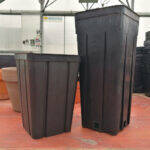
Among the peculiarities of the pots currently on the market, it is worth mentioning the anti-spiralization grooves. These are small canals that run along the edges of square vases so that the roots avoid, over time, to turn around the inner walls of the vase, creating tangles that are difficult to untangle when repotting. Frankly, I have never had the chance to experience its usefulness, and when, during repotting, I have to deal with tangled roots, I arm myself with patience and try to free them as much as possible. Apart from the colour, the shape or the anti-spiralization channels, only one thing must never be missing in pots: the drainage hole or holes. Essential for all plants, they are even more so for succulent plants, which do not tolerate water stagnation or excessive humidity. In old terracotta pots, there is always a single drainage hole at the bottom. It’s wide enough to avoid excessive spills of soil, it can be covered with a stone or with a shard of another pot, and it is more than enough for the purpose.
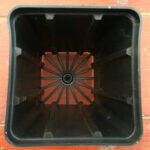
In plastic pots, especially in the square ones, there are usually more slits on the bottom to allow excess water to drain without the potting soil leaking out during repotting when it is dry and not yet settled. On the market, finally, you can also find pots with a semi-open bottom, that is, with a simple radius: in this way, the outflow of excess water is maximum, but it will be necessary, during repotting, to put coarse material on the bottom (lapillus or expanded clay) to prevent the soil from leaking out immediately.
How to choose the pot: the criteria
In the light of the elements just described, choosing the right pot wherever to place a cactus or a succulent plant might seem a difficult task. Actually, all you need is a little experience and knowledge of your cultivation method and of the conditions that you will be able to ensure to your plants: for example, air, full light, minimum temperatures, frequency of watering and fertilizing, type of substrate. The rest is just a compromise between one’s aesthetic taste and the functional aspect. It’s essential to respect the plant’s root system structure and ensure sufficient space for the specimen’s development and growth. You don’t need “bathtubs”, but you should avoid the tiny pots (under 5 centimetres) in which we almost always find succulents in non-specialized gardens. The correct potting soil and the right cultivation will do the rest.
SUBSCRIBE TO THE SITE – If you liked this article, subscribe to the site to have access to all the contents for one year or three months depending on the formula you choose. Here you will find terms and conditions.
SUBSCRIBE TO THE NEWSLETTER – If you want to receive the free newsletter every time new content is published (even if you have not subscribed to the site), fill in the fields at this link!
Correlated articles
Six identical cacti in three different soils
How to repot cacti and succulent plants
Substrates for cacti and succulents
The correct soil: the materials you can use
© The texts, videos, photos and graphic elaborations of the site “Il fiore tra le spine” are original material and are covered by copyright. It’s forbidden to reproduce them in any way.


